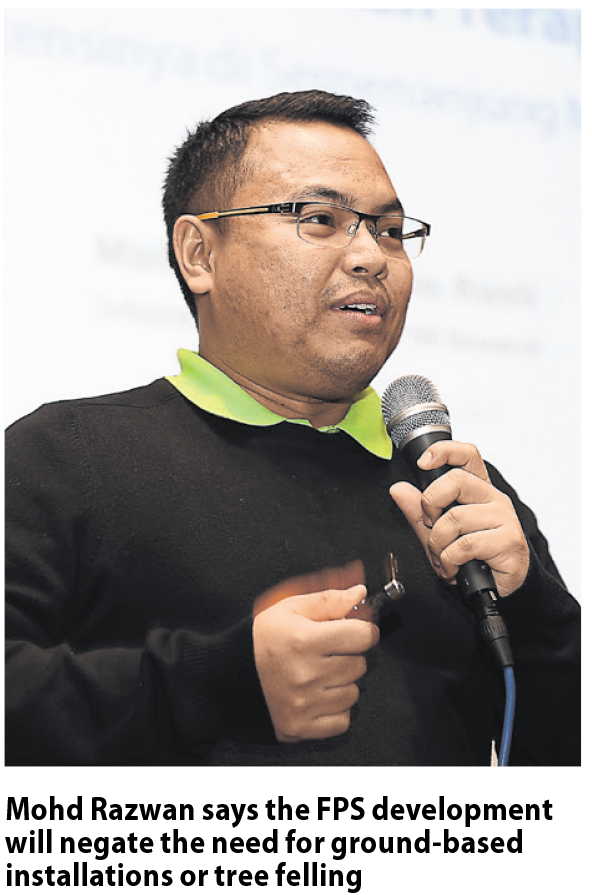With some 70 lakes found suitable in Peninsular Malaysia for developing floating photovoltaic (PV) systems, Tenaga Nasional Bhd (TNB) has just embarked on its a 100kWp pilot system in Sg Labu Water Treatment Plant in Sepang, Selangor. The project, which is owned by the Ministry of Energy, Green Technology and Water, is 80% funded by the Malaysia n Elect ricit y Supply Industries Trust Account or known by its Malay acronym AAIBE (Akaun Amanah Industri Bekalan Elektrik), while the rest is by TNB.
The RM3.95 million project will span around 1,000 sq m over a 50ha lake. The pilot floating PV systems project commenced in March 2015 and is scheduled for completion by November 2016.
Should the project proves to be successful, TNB will look at how to replicate and promote the initiative in the other lakes which have a combined surface area of 1,001.9 sq km (100,190ha).
 “If we take up just 10% of the total surface of these lakes to fix floating PV systems, we can generate 8.4TW-hours of electricity,” TNB Research Sdn Bhd’s green technology researcher Mohd Razwan Rusli said to reporters recently at TNB’s Media Familiarisation programme in Cameron Highlands.
“If we take up just 10% of the total surface of these lakes to fix floating PV systems, we can generate 8.4TW-hours of electricity,” TNB Research Sdn Bhd’s green technology researcher Mohd Razwan Rusli said to reporters recently at TNB’s Media Familiarisation programme in Cameron Highlands.The system is ideal for installation in water reservoirs and water catchment areas as well as several holding ponds used by the Stormwater Management And Road Tunnel.
While it is the first of its kind in Malaysia, neighbouring countries have ventured along this path.
Similar system has been installed for raw water catchment/pond in Cheongju, South Korea and in Okegawa, Japan.
Singapore’s Economic Development Board and national water agency Public Utility Board are launching its US$8.6 m illion (RM32.17 million) pilot floating solar farm in Tengeh Reservoir. It is capable of generating energy enough for the consumption of 1,000 Housing and Development Board households.
Japan will soon have what is said to be the world’s largest floating solar power plant, with a total capacity of 1.7MW installed on Lake Nishihira in the region of Hyogo.
Mohd Razwan said the floating PV systems development will negate the need for ground-based installations or tree felling. It may also reduce unwanted algae growth and water evaporation rate, and can be integrated with a hydroelectric power plant to minimise the effects of voltage fluctuations from the PV system.
One major challenge in large-scale deploy ment of ground-based photovoltaic system is securing land of sufficient size.
On average, a 1MWp solar plant requires four acres of land. The cost to purchase or rent can advsersely affect the return-oninvestment of the project.
The PV system on agricultural land also poses its own set of challenges.
“Placing the solar panels on water bodies frees up land for agricultural use, conservation or other development. More importantly, we don’t have to clear land to make space for the system,” he added.
He said that installation of PV system on water bodies may minimise water evaporation by lowering the water temperature and reducing the size of water area exposed to air.
The cooling effect of the water on both the panels and the electrical equipment is said to be beneficial as the floating PV systems would yield higher power output than conventional solar power system.
“One major problem for solar panels is the loss of power with the increase of temperature,” he said. Estimates suggest a loss of 0.41% power for every 1% increase in temperature.
Solar panels in a conventional power system across a tropical region like Malaysia can reach temperatures of 60°C-70°C on a hot day, which can reduce the PV system’s power output to between 14% and 24%.
“There is also the potential reduction in algae growth due to reduced sunlight penetration,” he added.
Since no excavation work is required, Mohd Razwan said the implementation has little or no impact on existing ecosystems.
“Although this source of renewable energy needs a high initial capital, the maintenance cost is very minimal. The system could also be installed in homes with the option of selling it back to utility companies such as TNB,” he added.
Discover the solution that will be installed in Sungai Labu Reservoir.

